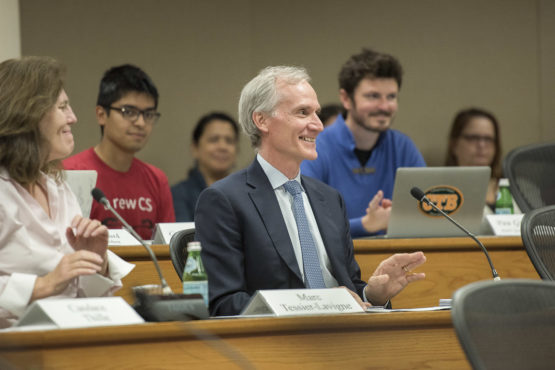Senate discusses leadership climate at Stanford, trends in undergraduate degrees
The speakers at the Oct. 13 meeting included Margot Gerritsen, an associate professor of energy resources engineering; Russell Berman, a professor of German studies and of comparative literature; and Brian Cook, a senior assessment and evaluation analyst. Stanford President Marc Tessier-Lavigne spoke briefly at the start of the meeting.
The Task Force on Women in Leadership has developed more than a dozen recommendations to help Stanford build an inclusive, supportive and inspiring environment for all leaders – not just women, Margot Gerritsen, chair of the task force told the Faculty Senate yesterday.
Speaking at the Oct. 13 meeting, Gerritsen, an associate professor of energy resources engineering, said the recommendations included in the task force’s 100-page report are not prescriptive, but are designed to serve as a template for future planning.

President Marc Tessier-Lavigne responds to a warm welcome from the Faculty Senate at its first meeting of the academic year. (Image credit: L.A. Cicero)
“In our interviews, we found that the climate for leadership and the way that people look at leadership at the university really varies a lot across campus,” she said. “By the way, one of the reasons we did not make a ‘toolkit’ was because we couldn’t find one that would fit all. It’s really important that every unit and school dive a little bit deeper and try to understand better what the barriers are for them. It may be different for the School of Medicine than it is for Engineering.”
The task force, which distributed its report to faculty over the summer, conducted more than 50 interviews with current and former Stanford leaders. Provost John Etchemendy, who convened the task force in 2014, asked the group to recommend ways to improve the leadership climate on campus and move Stanford toward fully inclusive leadership.
Gerritsen said the interviews revealed that female faculty members experience gender bias, feel more scrutinized and less respected than their male counterparts, and struggle more often than men with work-family conflicts when seeking leadership positions.
The task force’s interviews also revealed that male and female faculty members would like the selection process for leaders to be more transparent and more inclusive, she said.
Tessier-Lavigne speaks
At the start of the meeting, President Marc Tessier-Lavigne, who took office Sept. 1, announced he will address the senate at its next meeting on Oct. 27.
Meanwhile, Tessier-Lavigne said he wanted to give the senate an update on what he has done since arriving on campus.
He said he has focused most of his attention on four priorities: reaching out to the campus community to listen and to learn from faculty, students, staff, alumni and others; introducing himself; working on the appointment of a new provost; and getting ready for a long-range planning exercise that will begin in January.
Tessier-Lavigne said he hopes to announce Stanford’s next provost – he is considering only internal candidates – in November.
Trends in undergraduate degrees
Russell Berman, chair of the senate’s Planning and Policy Board and co-author of Changes in the Academic Interests of Stanford Undergraduates, said the report revealed that the percentage of women and underrepresented minorities majoring in engineering has grown since 1985.
Women comprised about 25 percent of engineering majors in 2016, compared with 10 percent in 1985, the report showed.
Underrepresented minorities comprised 37 percent of engineering majors in 2016, compared with 20 percent in 1985. (The category includes Black/African American, Asian/Asian American, Hispanic and Latino/a, Native American and Hawaiian/Pacific Islander students.)
“The report shows how gender and ethnicity is becoming less a predictor of major choice,” said Berman, a professor of German studies and of comparative literature. “That’s a success story.”
The report showed that undergraduate interest in computer science has been cyclical. Over the last 30 years, it peaked in 2002, fell precipitously until 2006, and began rising again in 2009. Now it is the most popular major on campus.
Berman said the report also showed declining interest in social sciences over the last three decades. In 1985, the social sciences accounted for nearly 30 percent of undergraduate degrees. By 2016, that percentage had fallen to 14 percent.
Brian Cook, a senior assessment and evaluation analyst at Stanford who co-authored the report, said the distribution of majors appears to be primarily a function of shifting academic interests among incoming students, and less influenced by changes in interests once students arrive on campus and begin taking classes.
“According to forms current freshmen filled out in the summer for their pre-major advisors, more than 50 percent of the current freshman class indicated that they were interested in an engineering major, up from 36 percent in 2007,” said Cook, who works in the office of Institutional Research & Decision Support.
Cook said the university’s Survey of New Students showed that incoming students’ perceptions of employment opportunities appear to play an important role in the rising interest in engineering.
“Eighty-five percent of current freshmen respondents to the survey said that they agreed or strongly agreed that getting a degree in engineering would give them ‘the best chance for employment’ compared to only 19 percent for degrees in the social sciences and just 16 percent for degrees in the humanities,” he said.
Cook said incoming students’ perceptions of their parents’ expectations also seem to play a key role in shaping their academic interests. Receiving a degree in the natural sciences, physical sciences and engineering were the only academic fields that survey respondents tended to agree would be “in line with family expectations.”
The full minutes of the Oct. 13 senate meeting will be available soon on the Faculty Senate website. The minutes will include the question-and-answer session that followed the presentations.
